README
This readme is accurate as of version v3.20.6.
Please read through the sections of this readme. There are MANY other features and other intricacies that are not mentioned, but do contain info inside the program.
You will learn best through experimentation; don't give up!
Launching the program
After decompressing/unzipping the zip archive, run the
run_windows.bat file by double clicking the batch file if you're on Windows,
or double-click the run_linux.sh if you're on a Linux operating system.
How does a remix work?
Remixes will go on forever
until you place an End Remix entity.
You can find this at Misc. > Special Entities > End Remix. Click and drag it onto the track.
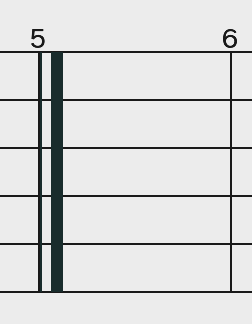
If you are familiar with music theory, this symbol also is used in sheet music to end the music piece. You can only have one of these in the track at any given time.
Entities are objects on the track that have a width. There are five main types of entities.
Cues play a single sound effect. They may also loop.
Patterns are groups of entities, usually other cues put together.
Random cues will randomly play a cue or pattern each time you play the remix. This is useful for games like First Contact, or Ringside.
Equidistant entities are for patterns like Built to Scale (DS) or Bouncy Road. By stretching the entity, you will change the time between cues. If you want your "do-re-mi-fa-so" (Built to Scale DS) to have 2 beats in between, just extend this entity to 2 beats long. The editor will take care of adding the other cues for you!
Keep the beat entities are for games like Lockstep, Flockstep, or any other game that has a consistent pattern. By stretching this entity, you can make constant beats without laying down multiple patterns.
Starting a new remix
The parameters you need to set when starting a new remix (such as the tempo) are covered in this document. You should, however, read up on the controls first below!
Controls
In-Editor Shortcuts
| Control | Action |
|---|---|
SPACEBAR |
Play/stop remix |
SHIFT+SPACEBAR |
Pause/resume remix |
BACKSPACE or DEL |
Delete selection |
INSERT or P |
Store selection as a stored pattern (as of v3.12.0) |
CTRL+N |
New remix |
CTRL+O |
Open remix |
CTRL+S |
Save remix |
CTRL+E |
Export remix |
CTRL+Z |
Undo |
CTRL+SHIFT+Z or CTRL+Y |
Redo |
F |
Quick switch to last game (doesn't work in search results) |
UP or W |
Scroll up (only in editor) |
DOWN or S |
Scroll down (only in editor) |
SHIFT+SCROLL |
Pan camera (hold CTRL to increase speed) |
TAB |
Cycle through scroll modes (pitch or volume) |
CTRL+K |
Focus search bar |
CTRL+SHIFT+A |
Select all entities |
CTRL+F |
Select entities following selection or playback start |
CTRL+R |
Select entities preceding selection or playback start |
CTRL+T |
Select entities between selections |
CTRL+C |
Copy selected entities to clipboard |
CTRL+X |
Cut selected entities to clipboard |
CTRL+V |
Begin pasting entities from clipboard |
F11 |
Toggle fullscreen mode |
SHIFT+F11 |
Revert to 1280x720 windowed mode |
| Camera pan controls | |
Holding CTRL or SHIFT will accelerate the camera pan speed |
|
A or LEFT |
Pan camera left |
D or RIGHT |
Pan camera right |
HOME |
Jump to beat 0 |
END |
Jump to last entity/End Remix entity |
M |
Jump to Music Start tracker |
| Selection Tool only | |
RIGHT CLICK on empty space |
Set playback start |
MIDDLE CLICK or CTRL+RIGHT CLICK on empty space |
Set music start |
MIDDLE CLICK or CTRL+RIGHT CLICK on an entity |
Jump to that entity in the picker |
On the top bar, you will see various buttons. Hover over them to view
what they're used for.
For detailed info, see this page.
On the bottom half of the screen, you will see icons for each
game on the left, and patterns and cues for the selected
game on the right. Using the Selection tool, you can drag
from the pattern area up to the track to place down patterns.
SCROLL or click on the arrows to cycle through your options.
You can click on the speaker button on the right to preview the pattern.
In the bottom-right, you will see tools:

From left to right: Selection, Multipart Split, Tempo Change,
Music Volume, Time Signature, Swing, and Ruler. They will be explained below.
You can access them quickly by pressing 1-7 on the number keys. Pressing R will also select the Ruler tool.
To the left of the tool buttons you'll see a minimap.
LEFT CLICK will jump the camera to that position.
Hover over the minimap to bring up a preview.
Click the buttons on the sides of the minimap to pan the camera.
Right clicking these buttons will jump to the start and end of the remix respectively.
You can also go to the Info and Settings menu to disable the minimap and/or the preview.
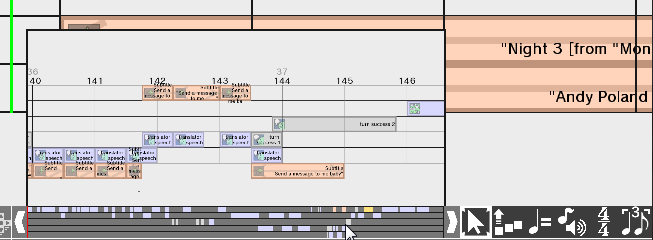
If the preview doesn't appear, check the Info and Settings menu. The preview may have disabled itself if your graphics driver is not able to support it.
Selection tool
The selection tool will be your main tool. It allows you to drag up cues and patterns from the pattern selector and create selections on the track.
Holding LEFT CLICK (not on a selected entity) will start a selection.
You can hold SHIFT to make it additive (i.e.: you can add to a
pre-existing selection). Starting in v3.1.0, holding CONTROL will
make it an inverted/XOR selection.
RIGHT CLICK will cancel the selection.
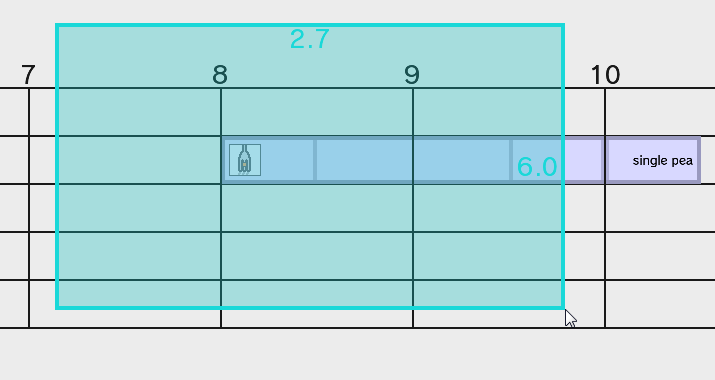
After you have made your selection, you can hold LEFT CLICK and
drag. You can drag it around anywhere as long as it's still fully in the track,
and doesn't collide with any other entities.
If you hold ALT while starting a drag, you will copy the selection.
If you hold CONTROL+ALT (SHIFT+ALT on macOS) while starting a drag, you will make what's called
a response-copy. For games like First Contact or Working Dough, making a
response-copy of the "leader" cues will make a special copy of the player
cues! This is one example of new functionality added to RHRE3.
Pressing BACKSPACE or DELETE with a selection made will delete it.
Scroll Mode

SCROLL or UP/DOWN will do the following based on the
scroll mode (changeable with the button on the toolbar or by pressing TAB):
* Change the pitch of any selected cues by a semitone, if possible
* Holding CTRL will change it in increments of two
* Change the volume of any selected cues in increments of 5%
* Holding CTRL will change it in increments of 25%
Playback Start
The Playback Start (default green) tracker will be the starting point of the
remix each time you play it. This is controlled through RIGHT CLICK.
Keep setting this as you build your remix so you can quickly listen to it.

Music Start
The Music Start (default red) tracker is the starting point of the music.
This is controlled through MIDDLE CLICK or CTRL+RIGHT CLICK.
If you notice that everything is slightly offbeat, or the music has a period of silence,
consider moving this tracker backwards so the actual music will start on time.

If you hold SHIFT after starting to move the music start tracker,
you will unlock snapping and be free to move it as precisely as needed.
Note: As of
v3.7.0, the Music Start tracker only shows the seconds. For each beat on the track, the Music Start tracker will be at that value in seconds. (Example: putting it where beat 1 is actually puts it at second 1.) This change was made to make it more intuitive to use.
Multipart Split tool
The multipart split tool is very simple: LEFT clicking on a multipart entity
(that is, an entity made up of multiple entities like patterns, random cues,
equidistants, and keep-the-beats) will split it into whatever it was made of.
Use this when you need to fine-tune a pattern's components.
Tempo Change, Music Volume, Time Signature tools
These tools are very similar. The first two control what are called trackers, and the Time Signature tool controls time signatures.
Note: wherever you see
SCROLL, you can substitute this withUPorDOWN. This is useful if you don't have access to a mouse, like on a laptop.
All tracker-like tools share these controls:
LEFT CLICK - Place tracker
RIGHT CLICK - Remove tracker
SCROLL - Change value
Hold CONTROL - Change value by 5x

The tempo change tool can change the tempo
mid-remix. You can hold SHIFT to change it in increments of 0.01 BPM.
Holding CONTROL while holding SHIFT will change it in increments of
0.5 BPM. You can also click and drag the ends to make it a linear gradient of change, but this is tricky to do correctly.

The music volume tool lets you change the music volume
mid-remix as a percentage from 0-200%. Starting in v3.6.0, clicking and
dragging the ends will allow you to make smooth transitions
for a perfect fade-out.
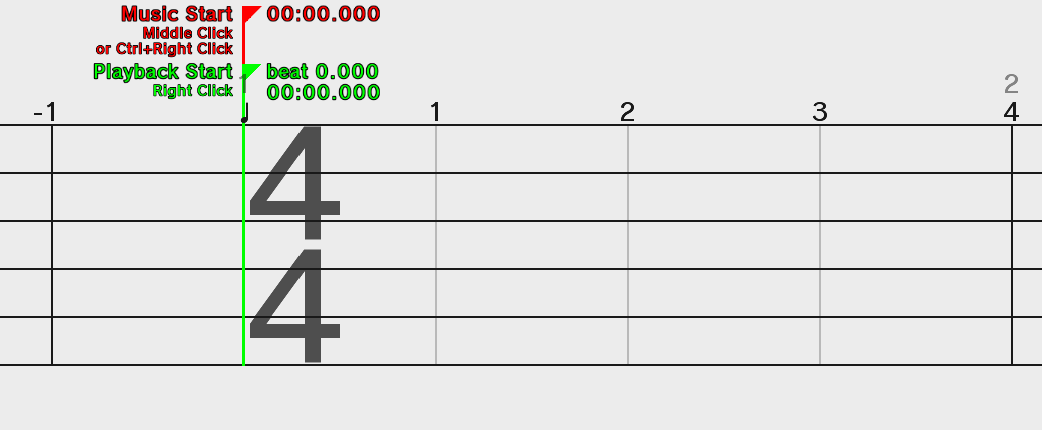
The time signature tool changes the time signature. It supports lower beat units
of 2, 4, 8, and 16. Use this tool to your advantage
to create measures so your patterns don't sound "off". You can only place this
on non-negative beats.
Swing tool
The Swing tool is covered in its own article here.
Ruler tool
The Ruler tool helps you measure beat distances. This is mostly intended for
modding Rhythm Heaven games. Hold LEFT CLICK to draw the ruler.
Holding SHIFT disables the snapping. Pressing RIGHT CLICK on an entity will
copy its ID to the clipboard.

Note: The hex (0x30) rest notation will only be visible if Advanced Options are enabled.
Stored Patterns
By clicking on the Stored Patterns tab (the chest icon), you can drag down selections and store them for later.

If you'd like to share these with others, navigate to <user home>/.rhre3/storedPatterns and you'll
see a lot of .json files. Each one is a stored pattern. To see which one is which,
go to the list folder and open the list.json file.
Tapalong
The tapalong menu is recurring from RHRE2, this time it is inline with the editor. The main purpose of tapalong is to be able to tap to the rhythm of a song to determine its BPM.

Views
Views are useful ways of viewing your remix. You can mix and match views too.
Game Boundaries
This highlights all the game boundaries and where they transition at. A game is said to transition when a new cue/pattern from a different game is introduced. This view also works in presentation mode.

Live Waveform
This shows the live audio data as the remix plays. This view also works in presentation mode.
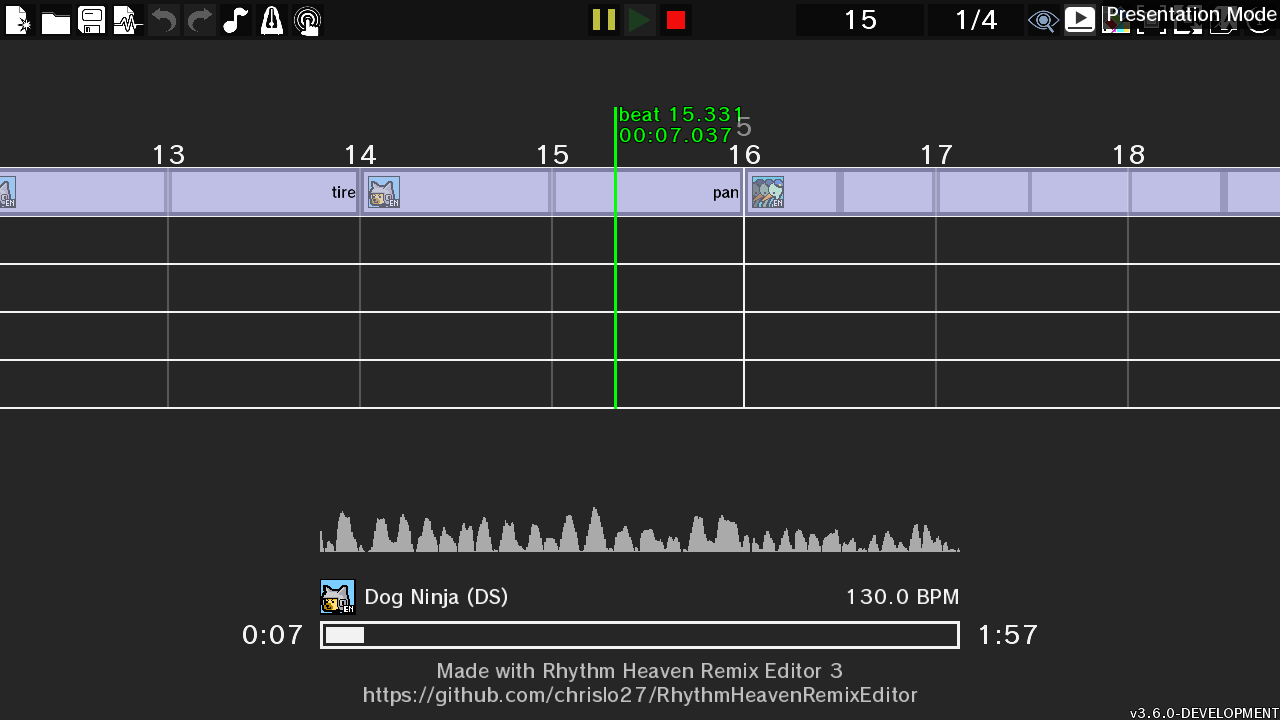
Glee Club (midis only)
This shows the tracks of a loaded midi file as Glee Club singers. Their heights represent the note they are playing.

